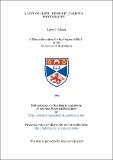Files in this item
A love of light : Herschel, Talbot & photography
Item metadata
| dc.contributor.author | Schaaf, Larry J. | |
| dc.coverage.spatial | 415 p. | en_US |
| dc.date.accessioned | 2018-07-09T09:08:40Z | |
| dc.date.available | 2018-07-09T09:08:40Z | |
| dc.date.issued | 1992-07 | |
| dc.identifier.uri | https://hdl.handle.net/10023/15089 | |
| dc.description.abstract | William Henry Fox Talbot (1800-1877), the inventor of photography on paper, was given crucial support by his colleague Sir John Herschel (1792- 1871). Fellows of The Royal Society, the two men made fundamental contributions to optics, chemistry, light, and mathematics. Both were humanists of diverse interests and had strong role models in women. For Talbot, it was his mother, Lady Elisabeth Feilding. Herschel learned some of his earliest science from his Aunt, Caroline Herschel; his wife, Margaret, was an active participant in his work. During the pre-history of photography, Mrs. Fulhame, Thomas Wedgwood, Sir Humphry Davy, and Nicephore Niepce demonstrated its potential. The question is why, rather than how, was photography invented and announced in 1839? The camera and the chemistry necessary for the art's invention co-existed for many decades. Frustrated in trying to sketch with Wollaston's camera lucida, Talbot conceived of photography; Herschel avoided making photographs because he was an expert draughtsman adept with the camera lucida. Herschel, following inductive reasoning, made seminal contributions to the field of photochemistry; he invented the cyanotype process and was the first to apply hypo to fix photographs. Talbot learned from his own photographs and grew into being the first photographic artist. Talbot and his rival, Louis Daguerre, mirrored the competitive economic race and differences in support of science and art between France and Great Britain. By the Great Exhibition in 1851, Herschel and Talbot had been forcefully removed from work in photography. Herschel's health was broken in service as Master of the Mint. He remained an important influence on other photographers, including Anna Atkins, Charles Piazzi Smyth, and Julia Margaret Cameron. Talbot learned from experience in photographic book publishing that silver photographs could never be made permanent. He applied his efforts to perfecting photoglyphic engraving, a forerunner of photogravure; he also invented the photographic halftone. | en_US |
| dc.language.iso | en | en_US |
| dc.publisher | University of St Andrews | |
| dc.subject.lcc | TR78.S2 | |
| dc.subject.lcsh | Henry Fox Talbot | |
| dc.subject.lcsh | Photography | |
| dc.subject.lcsh | John Herschel | |
| dc.title | A love of light : Herschel, Talbot & photography | en_US |
| dc.type | Thesis | en_US |
| dc.type.qualificationlevel | Doctoral | en_US |
| dc.type.qualificationname | PhD Doctor of Philosophy | en_US |
| dc.publisher.institution | The University of St Andrews | en_US |
This item appears in the following Collection(s)
Items in the St Andrews Research Repository are protected by copyright, with all rights reserved, unless otherwise indicated.

